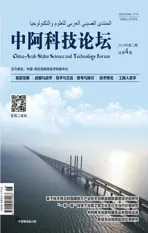Research on Smart Automotive Industry in Chongqing on the Base of Technology Foresight
2018-05-15ZhaoDeXuXiangWangChaochaoWenLei
Zhao De,Xu Xiang,Wang Chaochao,Wen Lei
(Chongqing Academy of S&T for Development,Yubei,Chongqing,401123)
Abstract:As the theoretical system of technology foresight is gradually enriched,the methods for technology foresight are gradually changing from a single certain method to a qualitative and quantitative comprehensive application.At present,China’s technology foresight is basically based on the Delphi method,and there are few practical cases in which quantitative methods are applied to technology foresight.In terms of scientometrics,the technology foresight research in the smart automotive industry was carried out,and the technical activity analysis method was used to conduct a quantitative analysis of the technological research frontiers and development trends of intelligent vehicles.The research found the business or facilities specifically applied towirelesscommunication networks.Thehotspot of research and development in the future is the device that informs the driver,warns the driver or immediately gives the driver intervention,responds to approachingobstacles,and transmitssignalsbetween thevehiclecomponentsor between thesubsystems.
Keywords:smart vehicles;Technology Foresight;Delphi Method;technical activity
Introduction
In today’s world,science and technology are changing with each passing day and major technological breakthroughs are brewing.Subversive technologies will greatly change the production and life of human beings.The competition among countries is more reflected in the competition of science and technology.How to precede others depends on how countries deploy their scientific and technological development in the next few decades,such as industries of new energy,new materials,high-end equipment,etc.Under the characteristics of complication,crossdiscipline and high uncertainty of scientific and technological development,scientifically carrying out technical foresight research,objectively grasping the development trend of science and technology in a certain field,conducting forward-looking and strategic major key technology research,and judging the development trend of future science and technology can provide a basis for countries and regions to carry out medium and long-term scientific and technological planning and the formulation of science and technology policies.It is of strategic importance for the country to determine strategic development fields and lead thefutureglobal technological development.
1 Research Foundation of Domestic and Foreign Technology Foresight
British scholar Ben R.Martin is the most representative of the definition of technology foresight,that is“a step-by-step exploration process for the long-term future of science,technology,economy,environment and society,with the aim of selecting strategic research fields and general new technologies that can generate the greatest economic and social benefits”[1]. Technology foresight originated in the 1940s.In the 1970s and 1980s,the technology foresight based on Delphimethod became popular.Since the 1990s,the technology foresight activities in developed countries have mainly focused on qualitative methods.For example,they mainly use Delphi method, supplementing by technology roadmap and scenario analysis.“The National Key Technology Selection Study”completed in 1992 was the origin of China’s technology foresight.In 2001 and 2003,cities such as Shanghai and Beijing also carried out technology foresight work.The Chinese Academy of Sciences presided over the“China’s technology foresight research over 20 years”.it is China’s most representative technology foresight work,and it mainly uses the Delphi method.Subsequently,with many quantitative analysis methods becoming more mature, such as bibliometrics,patent maps,and knowledge maps,many scholars have introduced these new methods into technology foresight work,making the methods of technology foresight more abundant.From the development history of the technology foresight method system,the method of technology foresight is gradually developed from qualitative and quantitative to qualitative and quantitative comprehensive application and practice.
In the process of technology foresight,the most commonly used method is Delphi method.XX believesthat Delphimethod isan efficient method for solving complex problems through group communication.It owns the basic features as anonymity,feedback,convergenceand statistics,etc.XX believes that technology foresight has played an important role in the selection of major key technologies and the determination of technology roadmaps[3].Zhang Dongmeipointed out that the lack of experts’information sources and methods of analyzing information led to the limited rationality and cognitive bias of experts.She also proposed that patent information as a source of innovation technology information can be used as a reference for technology foresight[4-5].Qiao Yang pointed out that the quantitative research of patent literature can comparatively discover thelawsand characteristics of technology innovation,which can help researchers better predict the trend of technology innovation[6].Narin pointed out that patent bibliometrics can be used as a method for government performance evaluation and scientific and technological development foresight[7].XX pointed out that patent measurement can quickly determine the key technical fields of development by using mathematical methods to analyze and process patent information,and has complementarity in time range with the using of long-term prediction of Delphi method[8、9].
Based on the above theoretical basis and research experience,this study uses the theory and method of patent bibliometrics to analyze the status quo and development trend of Chongqing’s intelligent vehicle field and opens up a new path for the technology foresight practice in the field of intelligent vehiclesin Chongqing.
2 Development Status and Planning of Smart Vehicles
In abroad,the USDepartment of Transportation released the Safety Assessment Guide for Vehicle Driverless Systems in July 2017.The guide focuses on the automatic driving of L3 to L5.The vehicle company can start testing and deploy the automatic driving systemwithout waiting.At the same time,the self-assessment process in the development of automated driving has been simplified.Until August 2017,22 states and Washington DC,have passed relevant laws.
Domestically,the National Development and Reform Commission issued the“Intelligent Vehicle Innovation Development Plan” (Draft for Comment)in 2018,and plans to basically form technology innovation,industrial ecological road network facilities,regulatory standards product supervision network facilities,regulatory standards product regulation and information security system framework of China’sstandard intelligent vehicles by 2020.The new proportion of intelligent vehicles reached 50%,and the medium and high-level intelligent vehicles achieved market-oriented applications. The demonstration operations in key areas achieved results. The construction of intelligent road transportation systemhasmade positive progress.The coverage rate of vehicle wireless communication network(LTE-V2X)in large cities and highways has reached 90%,and Beidou high-precision space-time service has achieved full coverage.By 2025,the technological innovation,industrial ecology,road network facilities,standard network facilities,product supervision and information security systems of China’s standard intelligent vehicles will be fully formed.The new car is basically intelligent,and the high-level car is applied in a scale.“People Car Road Cloud”achieves high synergy,and the new generation of vehicle wireless communication network (5G-V2X) can basically meet the development needs of intelligent vehicles.By 2035,China’s standard intelligent vehicles will have a worldwide reputation,and they will take the lead in building an intelligent vehicle power,sharing an intelligent vehicle society of"safe,efficient,green,civilized"with people.
In terms of enterprises, China’s auto companies,including Changan Automobile,SAIC motor corporation limited and China FAW group corporation,have formulated their intelligent vehicle development plans. For example, Changan Automobile’s five-year plan for intelligent development released in 2017 shows that Changan Automobile will achieve automatic emergency braking system in 2018.Their intelligent vehicles will be equipped with a fully automatic parking system in 2019 and an automatic highway driving system in 2020.SAIC plans to achieve the autonomous driving function of structured and partially unstructured roadsin the next five years and realize the automatic driving function in the whole environment within the next ten years.FAW plans to release expressway products and depth perception and urban intelligence technology in 2020,with multi-task long-termhostingand smart city solutions to provide functions.In 2025,it will eventually realize platform operation of intelligent business service.The penetration rate of policies and products of highly automatic driving technology will reach over 50%.
3 Status and Trends of Intelligent Vehicles Research and Development
3.1 Decomposition and Patent Search of Intelligent Vehicles Technology
3.1.1 Technology Decomposition of Intelligent Vehicles
This research focuses on the future development technology of the intelligent automotive industry,focusing on the auto-driving related technology in intelligent vehicles,and analyzing the future technological evolution direction of the Chongqing auto industry through patent layout.According to data survey, literature measurement, expert consultation and other means,the opinions of the relevant industry authorities were heard,and finally the following technical classification table was formed.
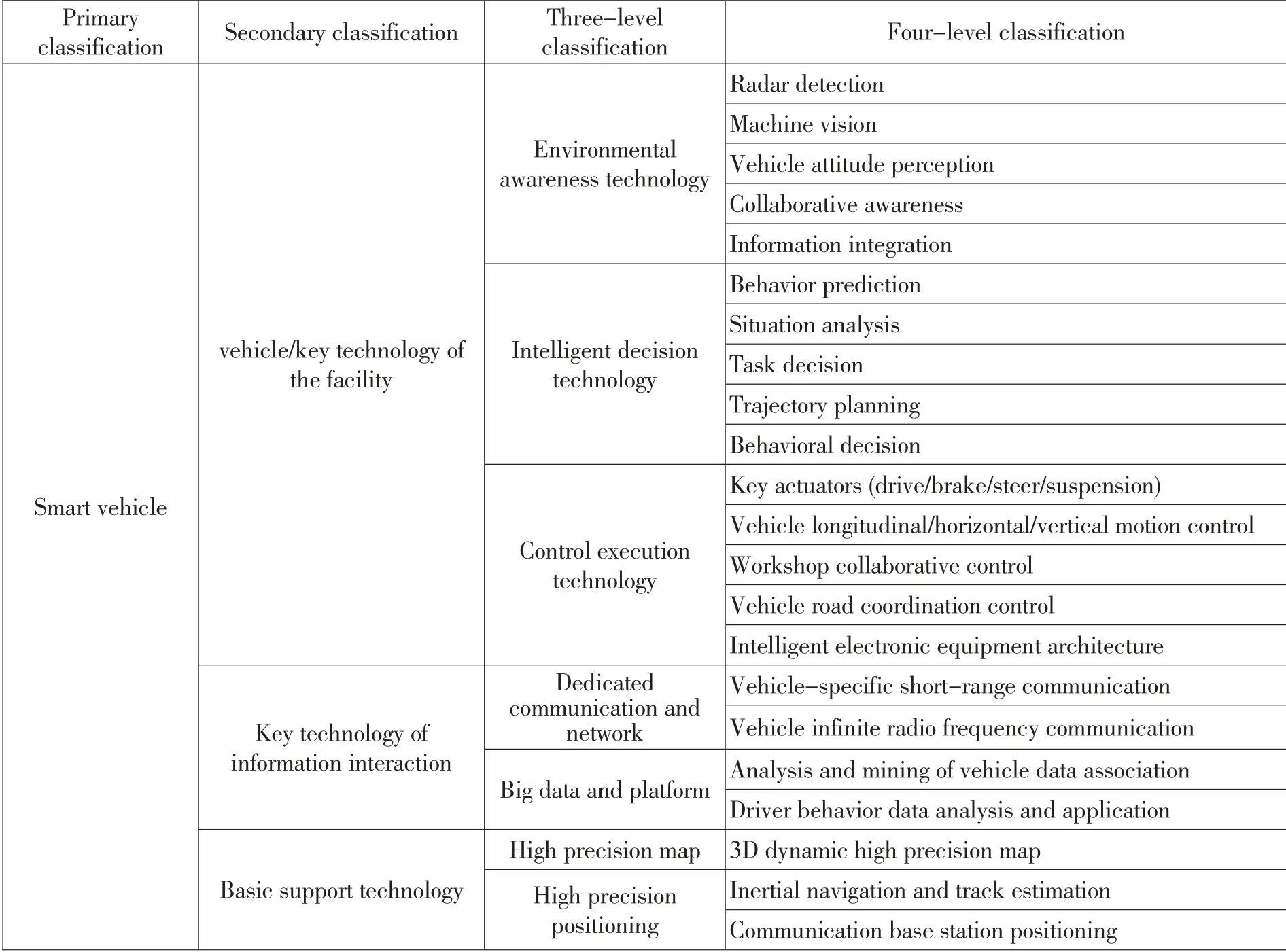
Primary classification Secondary classification Three-level classification Four-level classification Smart vehicle vehicle/key technology of the facility Environmental awareness technology Radar detection Machinevision Vehicleattitudeperception Collaborativeawareness Information integration Intelligent decision technology Behavior prediction Situation analysis Task decision Trajectory planning Behavioral decision Control execution technology Key actuators(drive/brake/steer/suspension)Vehiclelongitudinal/horizontal/vertical motion control Workshop collaborativecontrol Vehicleroad coordination control Intelligent electronic equipment architecture Key technology of information interaction Dedicated communication and network Vehicle-specific short-range communication Vehicleinfinite radio frequency communication Bigdataand platform Analysis and miningof vehicledataassociation Driver behavior dataanalysisand application Basic support technology High precision map 3Ddynamic high precision map High precision positioning Inertial navigation and track estimation Communication basestation positioning
3.1.2 Data Sourceand Retrieval
The data is from the Incopat commercial database.This study adopts the principles and methods of bibliometric analysis and uses MATLAB and Excel as the main analytical tools to conduct in-depth analysis of the retrieved data.The retrieval dateis June30,2018.
3.2 The Development Status of Smart Vehicle Patent Technology
3.2.1Trendsin SmartVehiclePatentApplications
The development of intelligent vehicle technology has gone through a long process.Before and after the 21st century,the number of patent applications for intelligent vehicles began to grow slowly.Especially after 2010,the number of patent applications for intelligent vehicles has exploded dramatically.During 2014-2016,the number of applications reached 3,727,accounting for 31.4%of the total applications.As countries adopt intelligent vehicles as an important direction for transformation and upgrading,the number of patent applications in thisfield will continuetoshowagrowingtrend,which reflects the importance that enterprises attach to intelligent vehicle technology and the degree of fierce competition in this field (due to patent applications-the lag period of the release time,the dataof 2017 and 2018 doesnot represent real data).
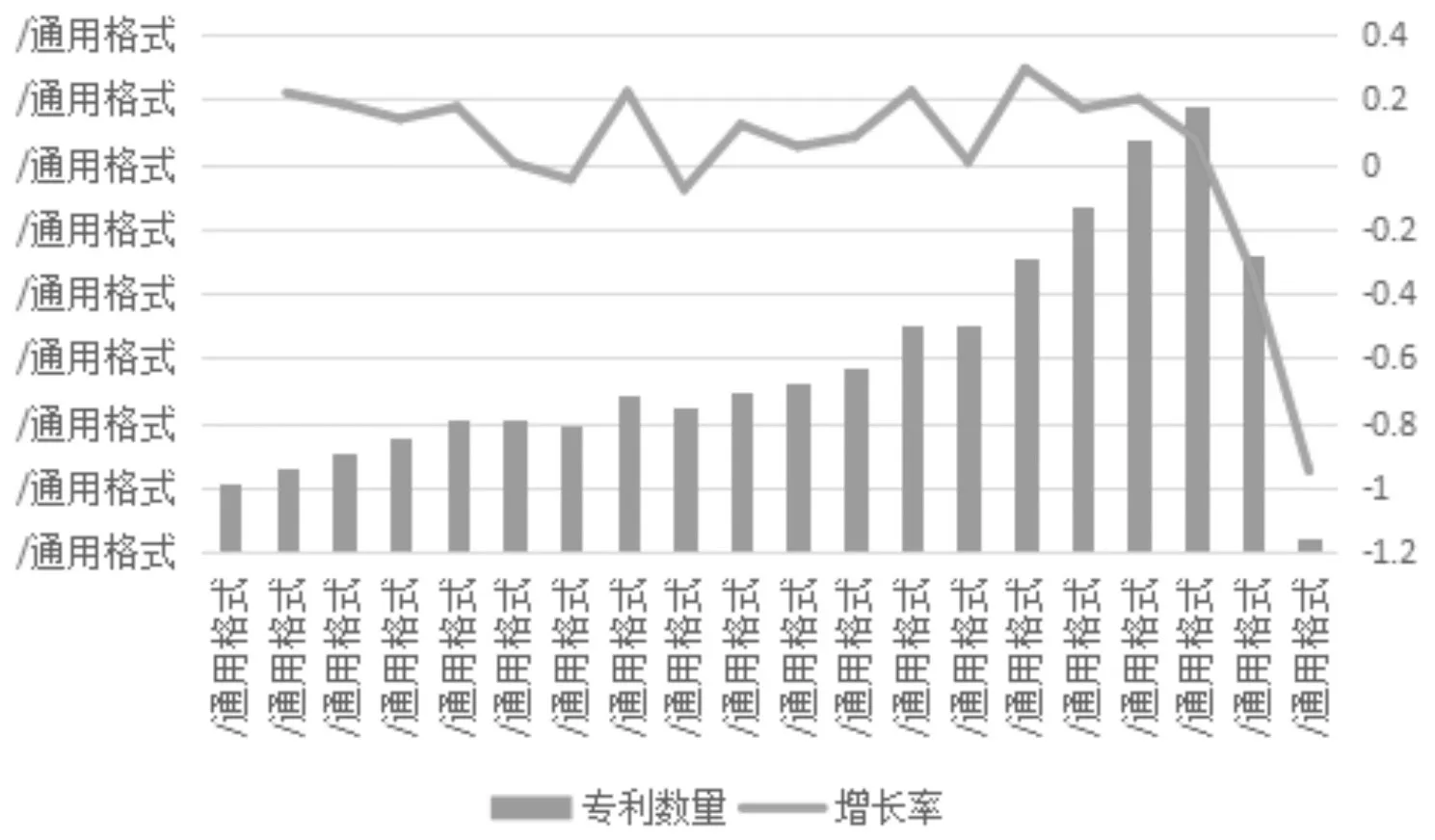
Chart 1 Sequence Diagram of Patent Applicationsfor Smart Vehicles
3.2.2 Research and Development Route of Smart Vehicle Technology
In the international patent classification system,the International Patent Classification Number(IPC)and its technical description are key words and sentences for analysis objects,which can be used to explain the development path and trend of analytical techniques.Aiming to track the development trend of important technologies of intelligent vehicles,the research and development of intelligent vehicle technology mainly focuses on the following aspects.First is the collision avoidance system(G08G1/16,512 pieces).Second is the electric power,which the servo motor is connected with the steering gear or the parts that constitute the steering gear(B62D5/04,312 pieces).Third is the two-dimensional position or channel control(G05D1/02,290 pieces).Fourth is the device that gives variable traffic instructions(G08G1/09,262 pieces).Among these,the collision avoidance system accounts for the highest proportion,which research and development of intelligent vehicle technology is currently concentrated in areas of collision avoidance systemsand so on.
3.2.3 Research and Development Trend Analysisof Intelligent Vehicle Technology
In order to better display the development status of subdivision technology and analyze the research and development trend of technology from the development hotspot of intelligent vehicles,this article takes the IPCgroup as the unit,the IPCof the top 50 patent applications as the classification object,analyzing the technology development trend of intelligent vehiclesthrough thetechnical activity.
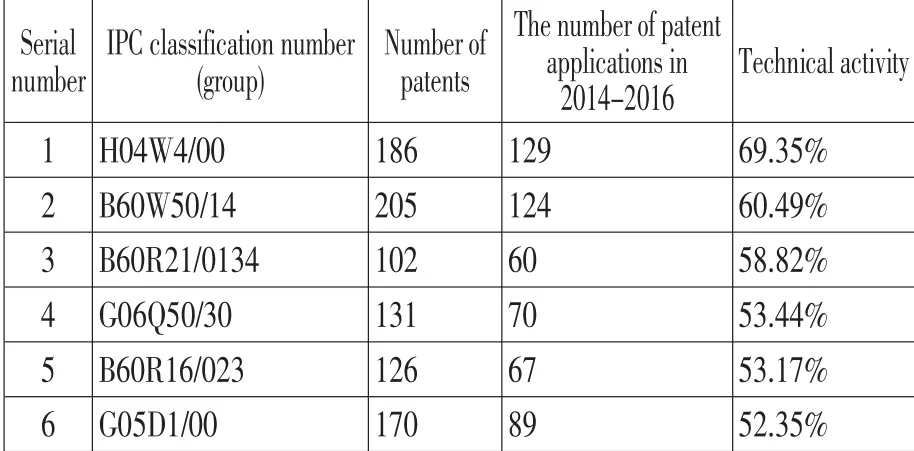
Table2 Technical Activity in the Field of Intelligent Technology
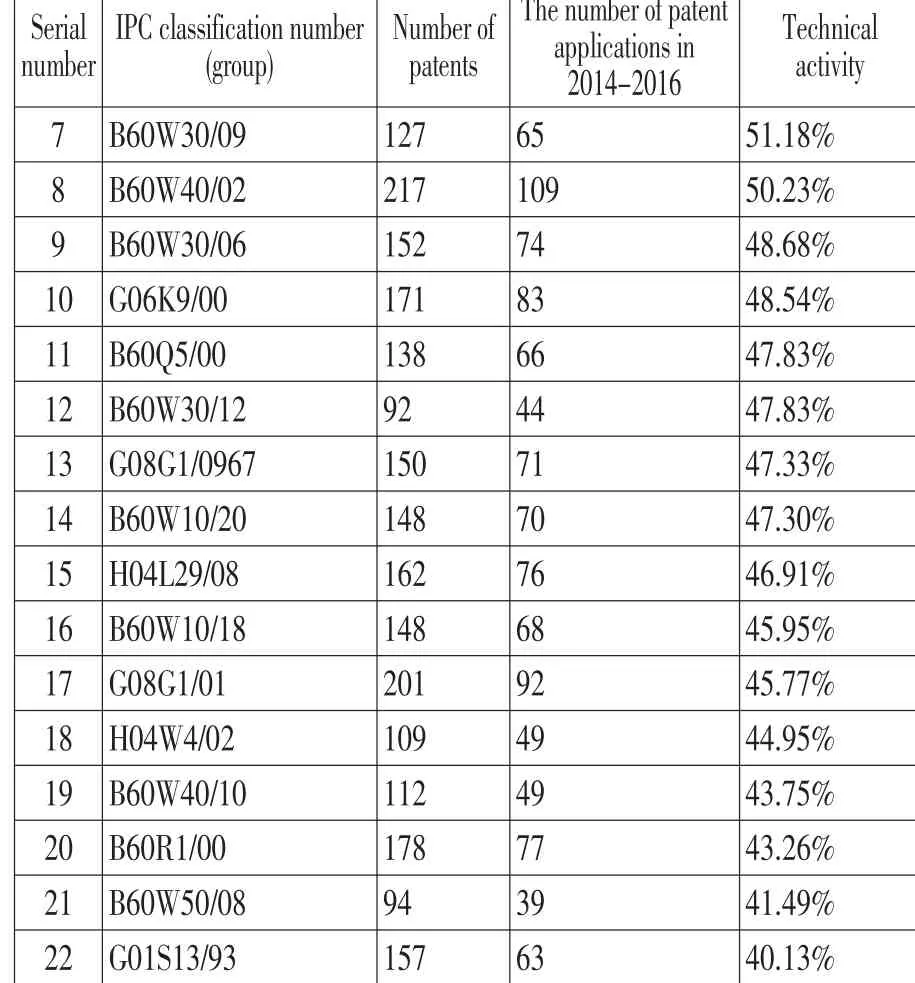
Serial number IPCclassificationnumber(group)Numberof patents Thenumberofpatent applicationsin 2014-2016 Technical activity 7 B60W30/09 127 65 51.18%8 B60W40/02 217 109 50.23%9 B60W30/06 152 74 48.68%10 G06K9/00 171 83 48.54%11 B60Q5/00 138 66 47.83%12 B60W30/12 92 44 47.83%13 G08G1/0967 150 71 47.33%14 B60W10/20 148 70 47.30%15 H04L29/08 162 76 46.91%16 B60W10/18 148 68 45.95%17 G08G1/01 201 92 45.77%18 H04W4/02 109 49 44.95%19 B60W40/10 112 49 43.75%20 B60R1/00 178 77 43.26%21 B60W50/08 94 39 41.49%22 G01S13/93 157 63 40.13%
The above table shows the technical activity of intelligent vehicle technology,and the technical activity which is less than 0.4 is not showed here.As can be seen from the above table,the most active technical activity of current intelligent vehicle technology isas follows.
First,the electrical communication technology,first of all,is specifically applicable to wireless communication network services or facilities(H04W4/00),transmission control procedures such as control procedures of data link level(H04L29/08),the servicesusing user or terminal location(H04W4/02).
The second is vehicle-related technology,including devices for informing the driver,warning the driver or immediately giving the driver intervention(B60W50/14), responding to approaching obstacles(B60R21/0134),transmitting signals between vehicle parts or between subsystems(B60R16/023).Automatic action is taken to avoid collisionssuch asbrakingand steering(B60W30/09),road conditions around the vehicles(B60W40/02),automatic operationsfor parking(B60W30/06).
Thethird iscalculations,counting that relatesto intelligent vehicle,including transportation and communication (G06Q50/30), for reading or recognizing printed or written characters or for identifying graphics,for example,methods or devices of fingerprints (for chart reading or a method or device for converting a graphic of a mechanical parameter such as a force or an existing state into an electrical signal into G06K11/00;speech recognition into G10L15/00)(G06K9/00);
The fourth is the signal device,including the system for transmitting highway information such as weather,speed limits (G08G1/0967),counting or controllingtraffic movements(G08G1/01).
4 Conclusion and Enlightenment
To implement technology foresight in the field of intelligent vehicles through the scientific metrology method,is an exploration of patent measurement in the quantitative analysis of technology foresight.It analyzes the research and development hotspots of technology activity and predicts the development trend of technology,making the method system of technology foresight more scientific and objective.
This paper takes the intelligent automotive industry as an example to carry out technology foresight research,which is not only the specific application exploration of quantitative methods in industrial technology foresight,but also provides reference for technology foresight research in other industries.The research finds that electrical communication equipment and software are still hotspots for research and development in the future.The system technology of transmission control procedure is an emerging technology hotspot.It adopts automatic actions to avoid collisions,and research and development of transmission signals between vehicle components or subsystems keep it active.The development of signal system technology continued to grow but the growth rate slowed down.With the demonstration and promotion of intelligent vehicles,technology development and related service equipment including measurement,maintenance and commissioning develop rapidly,which is an important guarantee for the future market development of this field.
杂志排行
中阿科技论坛(中英文)的其它文章
- 水性自干漆在高速公路护栏翻新中的应用
- Research on Performance Evaluation of China’s Local Industrial Technology Innovation Strategic Alliance Based on Technology Foresight:Taking Guangxi as an Example
- Study on Ethical Issues of Transgenic Technology from the Angle of Ecology,Livelihood and Life
- Application of Water-based Self-drying Paint in Highway Guardrails Refurbishment
- 论高校青年教师的培养
——以浙江医药高等专科学校为例 - Research on Video Monitoring Application of Intelligent Station
